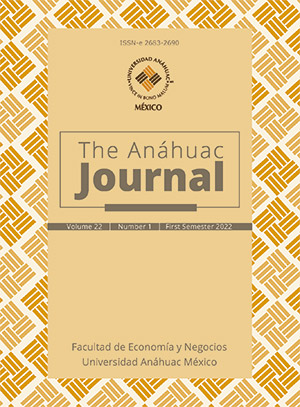Life-gambling: Metaphor Elicitation in Consumers during the COVID-19 Pandemic
Main Article Content
Abstract
The objective of the research is to understand consumer emotions which have been encountered during the COVID-19 health emergency, and which affect marketing and business. The study considers perceived risk and fear as moderators which, when directly put in relation to a particular set of COVID-19 pandemic-specific anxieties and stress, may serve to account for the gathered empirical data and therefore contribute to explain and predict changes in shopping frequencies and preferences. The study comprises a qualitative analysis using the ZMET methodology with interviews considering 40 men and women questioned about their experiences as consumers. The results show changes in consumption, emotions, and lifestyles; creating a new social norm governed by positive and negative emotions and defining issues of significant concern to post-pandemic consumers, such as adaptation, protection, health, technology, and family connection.
Downloads
PLUMX Metrics
Article Details

This work is licensed under a Creative Commons Attribution-NonCommercial-ShareAlike 4.0 International License.
This work is licensed under a Creative Commons Atribución-NoComercial-CompartirIgual 4.0 Internacional.
References
Addo, P. C., Jiaming, F., Kulbo, N. B., & Liangqiang, L. (2020). “COVID-19: fear appeal favoring purchase behavior towards personal protective equipment.” The Service Industries Journal, 40 (7-8), 471-490.
Agamben, G. (2021). Where Are We Now?: The Epidemic as Politics. (V. Dani, Trans.). Eris Press. https://aphelis.net/agamben-coronavirus-pandemic-interventions/
Alreck, P., & Settle, R. J. (2002). “Gender effects on Internet, catalogue and store shopping.” Journal of Database Marketing & Customer Strategy Management, 9, 150. https://doi.org/10.1057/palgrave.jdm.3240071
AMAI (2018). “Niveles socioeconómicos”. https://www.amai.org/NSE/index.php?queVeo=2018
Barajas, J., Mercado, J., Salinas, E. & Reyes, P. (2017). “Estudio sobre el fenómeno de las selfies en las redes sociales y sus implicaciones para el marketing.” The Anáhuac Journal: Business and Economics, 17, 2, 93-116.
Barros, D. (2021). “El 2020 según las búsquedas en Google.” Uncommon Finance.
https://uncommonfinance.com/el-2020-segun-las-busquedas-en-google/
Becker, E. (1997). The denial of death. Simon and Schuster.
Carveth, D. L. (2004). “The melancholic existentialism of Ernest Becker.” Free Associations, 11 (3), 422-429.
Chang, H. H., Fu, C. S., & Jain, H. T. (2016). “Modifying UTAUT and innovation diffusion theory to reveal online shopping behavior: Familiarity and perceived risk as mediators.” Information Development, 32 (5), 1757-1773.
Dowling, G. R., & Staelin, R. (1994). “A model of perceived risk and intended riskhandling activity.” Journal of Consumer Research, 21, 119-134. https://doi.org/10.1086/209386
Fabius V., Kohli, S., Timelin, B., & Veranen, S. M. (2020). “How COVID-19 is changing consumer behavior–now and forever.” McKinsey & Company. https://www.mckinsey.com/industries/retail/our-insights/how-covid-19-is-changing-consumerbehavior-now-and-forever
Forsythe, S. M., & Shi, B. (2003). “Consumer patronage and risk perceptions in Internet shopping.” Journal of Business Research, 56 (11), 867-875.
Ha, N. (2020). “The impact of perceived risk on consumers’ online shopping intention: An integration of TAM and TPB.” Management Science Letters, 10 (9), 2029-2036.
Hesham, F., Riadh, H., & Sihem, N. K. (2021). “What have we learned about the effects of the COVID-19 pandemic on consumer behavior?” Sustainability, 13 (8), 4304.
Jacoby, J., & Kaplan, L. B. (1972). “The components of perceived risk.” Proceedings of the Third Annual Conference of the Association for Consumer Research, 382-393.
Kierkegaard, P. (2008). “Fear of e-shopping: anxiety or phobia? ” International Journal of Technology Transfer and Commercialization, 7 (1), 83-90. https://doi.org/10.1504/ijttc.2008.018804
Kübler-Ross, E. (1973). “Life and death: Lessons from the dying.” In Robert H. Williams (Ed.), To Live and To Die: When, Why, and How (pp. 150-159). Springer.
Laato, S., Islam, A. N., Farooq, A., & Dhir, A. (2020). “Unusual purchasing behavior during the early stages of the COVID-19 pandemic: The stimulus-organism-response approach.” Journal of Retailing and Consumer Services, 57, 102224. https://
doi.org/10.1016/j.jretconser.2020.102224
Lins S, Aquino S. (2020). “Development and initial psychometric properties of a panic buying scale during COVID-19 pandemic.” Heliyon, 6 (9), e04746. https://doi.org/10.1016/j.heliyon.2020.e04746
Pavlou, P. A. (2003). “Consumer acceptance of electronic commerce: integrating trust and risk with the technology acceptance model.” International Journal of Electronic Commerce, 7 (3), 69-103.
Sheth, J. (2020). “Impact of Covid-19 on consumer behavior: Will the old habits return or die?” Journal of Business Research, 117, 280-283.
Slade, E. L., Dwivedi, Y. K., Piercy, N. C., & Williams, M. D. (2015). “Modeling consumers’ adoption intentions of remote mobile payments in the United Kingdom: Extending UTAUT with innovativeness, risk, and trust.” Psychology & Marketing,
(8), 860-873.
Tham, K., Dastane, O., Johari, Z., & Ismail N. (2019). “Perceived risk factors affecting consumers’ online shopping behaviour.” Journal of Asian Finance, Economics and Business, 6 (4), 249-260. https://doi.org/10.13106/jafeb.2019.vol6.no4.249
van Dessel, M. (2005). “The ZMET technique: a new paradigm for improving marketing and marketing research.” In ANZMAC 2005: Broadening the Boundaries: Conference Proceedings (pp. 48-54). University of Western Australia Business School.
Zaltman, G. (1997). “Rethinking market research: Putting people back in.” Journal of marketing Research, 34 (4), 424-437.
Zaltman, G. & Coulter, R.H. (1995). “Seeing the voice of the customer: Metaphorbased advertising research.” Journal of Advertising Research, 35 (4), 35-51.
Zaltman, G., & Zaltman, L. H. (2008). Marketing metaphoria: What deep metaphors reveal about the minds of consumers. Harvard Business Press.
Zwanka, R. J., & Buff, C. (2021). “COVID-19 generation: a conceptual framework of the consumer behavioral shifts to be caused by the COVID-19 pandemic.” Journal of International Consumer Marketing, 33 (1), 58-67.

